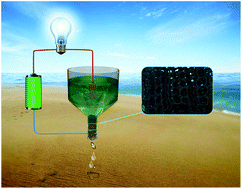Conductive 3D sponges for affordable and highly-efficient water purification†
Abstract
Effective, affordable and low energy water purification technologies are highly desirable to address the current environmental issues. In this study, we developed a low-cost method to achieve efficient organic pollutants degradation by incorporating conductive nanomaterials (i.e., carbon nanotubes, CNTs) to assist electro-oxidation, leading to an efficient conductive nano-sponge filtration device. The integration of electrochemistry has significantly improved the performance of the sponge-based device to adsorb and oxidize organic compounds in aqueous solution. In particular, CNT materials could serve as both high-performance electro-catalysts for pollutant degradation and conductive additives that make polyurethane sponges highly conductive. On the other hand, the polyurethane sponge could work as a low-cost and highly porous matrix that could effectively host these CNT conductors. The conductive sponge can be easily fabricated by a simple dying based approach. The as-fabricated gravity fed device could effectively oxidize two model organic compounds (i.e., >92% antibiotic tetracycline and >94% methyl orange) via a single pass through the conductive sponge under the optimized experimental conditions (e.g., [Na2SO4] = 10 mmol L−1, [CNT] = 0.3 mg mL−1, and [SDBS] = 2.0 mg mL−1). We have achieved >88% degradation efficiency for the antibiotic tetracycline within 6 h of continuous operation with an average electro-oxidation flux of 0.82 ± 0.05 mol h−1 m−2 and an energy requirement of 1.0 kW h kg−1 COD or <0.02 kW h m−3. These promising data make our CNT-sponge filtration device attractive for affordable and effective water purification.



 Please wait while we load your content...
Please wait while we load your content...